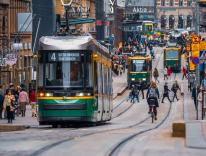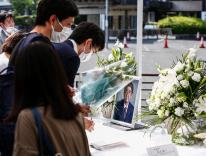NO NEED TO BE NERVOUS
This letter is in response to Peter Steinfels’s article on belief in the Eucharist and surveys (“More than a Symbol,” February). When I began teaching liturgy and sacraments in a major seminary in 1971, I taught the approach to Eucharist by way of the metaphysics of transubstantiation, including matter and form, substance and accidents, etc. Despite an effort of a few years, I was disappointed in the results. Many of the students had little philosophical background and limited capacity for abstract thinking. They memorized words rather than grasping the reality behind the words; it seemed to do little for their faith.
So I started over from the bottom up: an anthropology of meal, then the biblical theology of meals in the Hebrew Bible all the way up to the Last Supper and the dying and rising of Jesus. This was an approach by way of biblical symbolism. It all came together in the statement that the Eucharist is the real symbol of the Body and Blood of Christ—“real” in the constant affirmation of tradition that the Eucharist is the Body and Blood of Christ, and “symbolic” because it is not the gross realism of actually tasting flesh and blood; rather, the bread and wine we taste becomes the symbolic window through which we commune with the Body and Blood of Christ. Three elements: really Christ, through the symbol of bread and wine, into which we enter by faith. Always mysterium fidei.
I have shared this simple explanation with many groups over the years. Any mention of “symbol” makes some people nervous, but all worship is a symbolic structure. The scriptures and liturgical year are a symbolic structure. So are all the sacraments. We cannot teach or speak of or enter into any of them without a grasp of symbols.
Here is another supporting approach. Christian initiation is a symbolic structure of going down in the water (the dying of Christ), then coming up out of the water to new life (sharing in the risen life of Jesus) and being anointed with the Holy Spirit. We feel the water on our body, we feel the chrism on our forehead, but then we complete the initiation in receiving the Eucharist, in which the sacramental body enters into our own body. This is the densest and deepest of the sacraments, in which we become what we eat: the Body and Blood of Jesus forming us into the whole Christ.
A weakness of the metaphysical approach was that it ended up in presence, not eating. But perhaps it was useful in ages when people received the grace of the sacrament mainly by seeing the Eucharist and very rarely eating it. And sacraments were reduced to matter and form; all the rest was ceremony. The development of an adequate theology of symbol grasps all the ceremonies of liturgy and gives them full value.
There were many responses from groups to whom I have given this presentation. The ones I liked best were “satisfying” and “comforting.”
And by the way, I don’t believe in surveys. That would require a leap of faith well beyond the Eucharist.
Fr. Ken Smits
Fond du Lac, Wisc.
PETER STEINFELS REPLIES:
I am grateful for any effort like Fr. Smits’s to develop an adequate, understandable explanation of Eucharistic change and belief. He is right: a grasp of symbols is essential to sacramental theology. And an anthropology of meal—and also one of sacrifice—seem like welcome components of a full understanding of Eucharist. I hope he has spelled all this out in sufficient detail for his fellow theologians to engage and explore.
But I am not sure how seriously to take Fr. Smits’s closing remark. Is it a quip that resonates with all of us bombarded with polls and surveys of drastically varying quality, dizzying frequency, and ephemeral significance—about everything from the prospects of rival Democratic presidential hopefuls to favorite colors among M&Ms?
Or is it a way of dodging the entire thrust of my article, which was, after all, to warn liberal Catholics against reflexively dismissing any evidence (in this instance, surveys) suggesting that Catholics’ core belief in the Real Presence might be eroding? My article was hardly oblivious to the limitations of surveys. They are tools like any other. They can be faulty in design or misused in practice. They need to be examined critically, like any other bit of evidence, but not dismissed.
It is amusing that in the preceding paragraph, Fr. Smits writes of the “many responses from groups to whom I have given this presentation.” Do informal surveys like his have some value while ones conducted with more rigor and reporting unfavorable responses along with “ones I liked best” are useless?
Finally, I can understand why people are nervous about any mention of symbol. Given contemporary understandings of the word, it would probably be helpful for those using it in reference to the Eucharist to explain what they do not mean.
For example, God Matters by the late lamented Herbert McCabe includes several challenging chapters about Eucharistic presence, symbol, and sacramental language. He began, however, by describing the view that the food and drink in the Eucharist are “like a crucifix or a religious painting…symbols that remind us of Christ and form a focus for our faith in him…. To say that Christ is present…is not to say that the food and drink are in themselves in any way different from other food and drink, it is to speak of the role which they play in a particular religious ceremony.” He compares this to a bottle of champagne: “When it plays a role in a certain ceremony it becomes a Christmas present.” No change has taken place in the champagne, “but it now serves as a symbol of friendship and a focus of our mutual affection. Any Catholic theory of the Eucharist must distinguish itself from such a view.”
I suspect that McCabe’s clarity about what he was not saying about symbol opened his readers’ minds to the creative discussion that followed.
BEYOND THE BYGONE ERA
Michael Higgins’s article on how the Canadian Church has responded to the tragedy of clerical sex abuse was refreshing in its clarity and the numerous ways he notes that a more integrated national response by the church in Canada is needed (“Piecemeal Protections,” March). By way of contributing to the conversation, allow me to note that at St. Peter’s Seminary in London, Ontario, we have three female faculty members (myself included), as well as a female social worker who works with the seminarians on human formation, our librarian, and numerous staff members with whom the seminarians interact regularly. In addition, I recently was an invited guest in an upper-year practical-theology course wherein I shared with the seminarians my experience of boundary violations at the hands of Hod Marshall. It was a difficult, awkward, and painful thing to talk about, but it gave the seminarians in attendance firsthand experience of hearing the testimony of a victim and illustrated how quickly a boundary violation can take place. Although it is true that the seminary building has been refurbished, it would be a mistake to conclude that the culture of teaching and formation in the seminary has retained the status quo of seminaries of bygone eras. My hope is that the formation we are providing will yield good fruit that will last.
Andrea K. Di Giovanni
St. Peter’s Seminary
London, Ont.
Please email comments to [email protected] and join the conversation on our Facebook page.
Previous Story
The Orthodox Church & Social Teaching
Next Story
Bread Arrives


